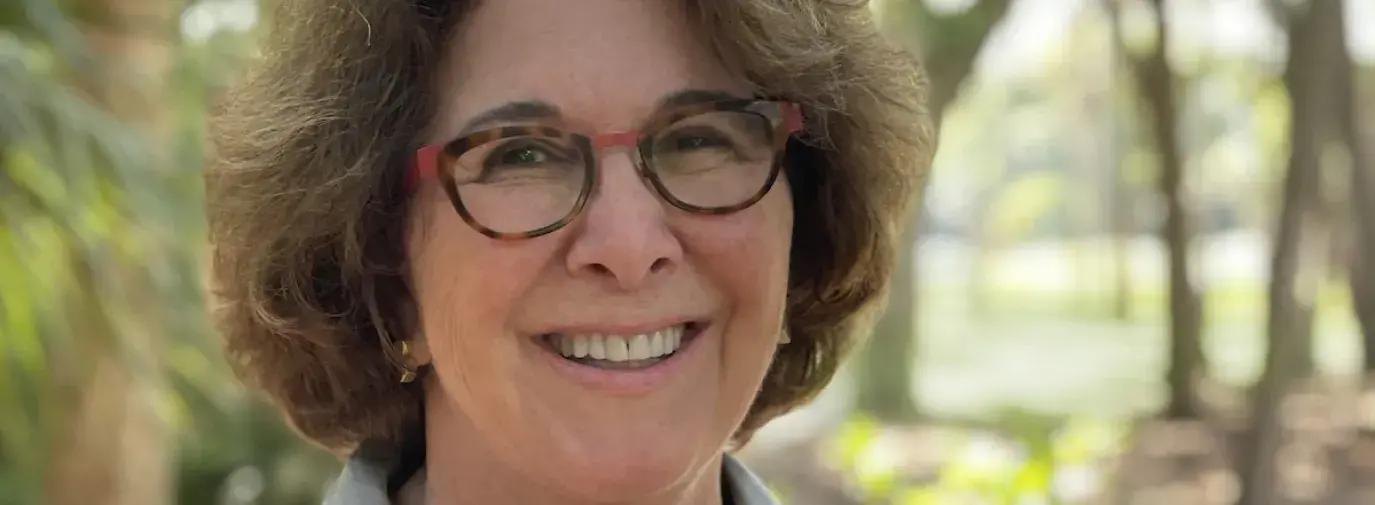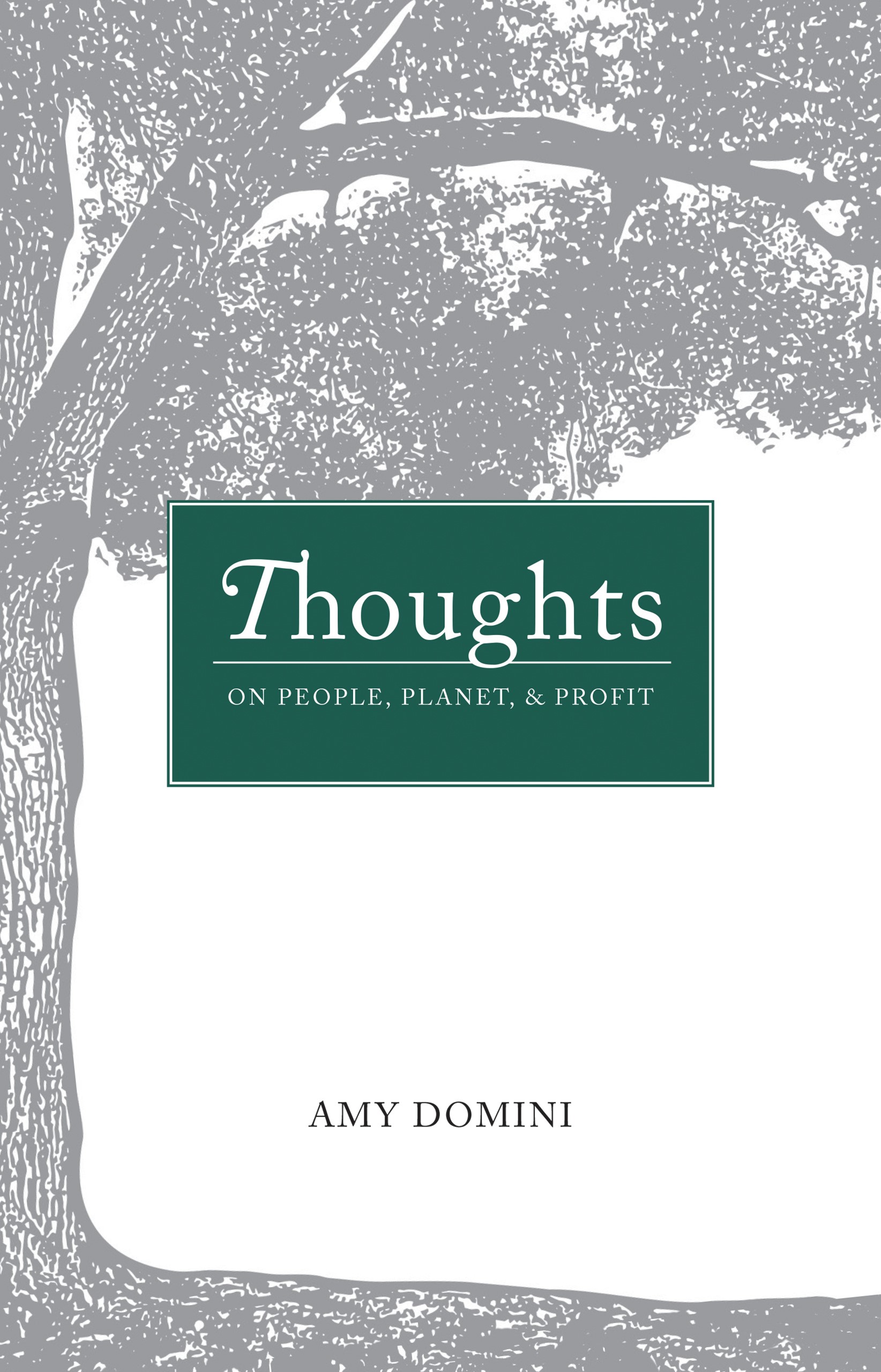
Written by Fran Teplitz
For the past twenty years I’ve educated and engaged people in how to bank and invest in ways that can help them achieve the kind of world they want for themselves and future generations. At Green America we talk about “voting with your dollars” – doing all you can to direct your purchasing and investing toward options that reflect your values, such as food grown organically, apparel not made in sweatshops, or banks that don’t finance fossil fuels. While I’m a big enthusiast for socially responsible investing strategies, I don’t exactly think of cozying up for a good read on the topic of investing.
Or I didn’t until I read Amy Domini’s new book, Thoughts on People, Planet & Profit.

The book is a collection of pieces Amy has written over the years and comes in celebration of the 30th anniversary of Domini’s first socially and environmentally responsible mutual fund. Amy is the founder and chair of Domini Impact Investments, a global leader on socially responsible investing, and long-time ally of Green America. Her's is not a typical “how to invest” book, but rather a “why to invest” book based on one’s deepest values.
Amy shares her childhood experiences, reflections on her investment clients’ goals, and insights about how positive change happens over time – far from perfectly, but in ways that matter. Our conversation about the book sheds more light on Amy’s thinking:
Fran: First off, congratulations on the 30th anniversary of the first Domini fund. What have you found most gratifying in your socially and environmentally responsible investing work over the decades? Most surprising? Most challenging?
Amy: Thank you! The 30th anniversary of launching our first mutual fund is indeed a thought to ponder.
What shifts we have seen through the years – not only in our world, but also in the acceptance and even admiration of Wall Street for the socially responsible investing field.
In terms of gratifying, there are a few landmarks, like the creation of the United Nations Principles for Responsible Investing and the evaluation of the legal framework for responsible investing by the acclaimed, international law firm Freshfields Bruckhaus Deringer. I certainly hoped for the likes of these, but never expected them. The leadership of global institutions towards encouraging -- and in some cases mandating -- integration of environmental and human impacts in investment decisions has been stunning. We have gained acceptance by all major financial asset managers, leading to growth of the field to levels that actually move the needle. Our approach is affecting what corporate management follows, reports out, and therefore implements.
What surprises me? I am surprised that we cannot gel on a single vocabulary for the field. From where I sit, responsible investing, impact investing, socially responsible investing, ESG investing, triple P bottom line (people planet profit) investing, and other terms all refer to the same methodologies and goals, so why is it so hard to pick a definitional phrase and stick with it?
For most challenging, I think I’d put lack of full support for socially responsible investing by U.S. regulatory bodies near the top. We need a few simple things. We need the Securities Exchange
Commission to identify a handful of ‘starter’ reports that are mandatory and monitored. Currently we basically have four: Environmental liabilities that may be material (severely under-reported and never subject to SEC challenge), occupational health and safety (very useful), mineral extraction from certain nations (relatively new, but helpful), and CEO compensation (helpful but not yet leading to impact). My hope would be that a half-dozen more simple reports be added, developed, studied for efficacy, altered and expanded.
Just think about it – disclosure can drive change. The Home Mortgage Disclosure act was created in 1975, when concern over discrimination in mortgage lending in certain urban neighborhoods was rising. Its purpose was to highlight areas that seemed to be held aside for white purchasers. The Act doesn’t require any remedy, just disclosure. But over the years, the existence of this data has made a huge difference. Advocates for fair housing use it, banks attempting to remedy inequalities use it. Just the disclosure makes important change possible. Or today, Carbon Disclosure Project was formed in 2002. CDP helps companies report on their environmental impact from a risk management perspective. Since then over 8,400 companies have reported, as have hundreds of cities. This information is then used by the corporations themselves to remedy low scores or by regulators working to create a lower risk future. Again, merely having data leads to change.
We also need the Department of Labor to specifically state that the beneficiary of a retirement plan is a human. The economic benefit of a plan is NOT an appropriate outcome of pension management. The well-being of the human is.
Fran: Re-reading these columns with the passage of time, what stood out for you the most about their meaning when you first wrote them, and today?
Amy: I was particularly pleased with the way these columns wove together into an overarching storyline. There are three basic components to my field and to this book: people, planet and profit logically intertwine. The intertwine can be very positive if we investors are deliberate about prioritizing that outcome. A second point of pleasure was in realizing that by dating each piece, it became clear that the thoughts were quite timeless. The messages did not seem dated to me, the needs are still real, and seem more achievable in some cases.
Most disappointing, however, is knowing that we have lost the chance forever of a stable climate. Mitigation cannot get us back to where we were. Perhaps 200 years of making planting trees a global priority could, but can we survive the wait? Still, in general I am actually startled at how current the various thoughts still feel.
Fran: I found your stories very compelling in part because they are so personal; you link life experiences and events with investment decisions. A poignant example is your description of growing up in Newton, MA and attending Sandy Hook Elementary School. The horror of the mass shooting at the school years later furthered your resolve to avoid investment in weaponry. For people who haven’t thought about investing in line with their values, what have you found to be the most effective approach for introducing that concept?
Amy: Gosh Fran, thank you. That idea, of personalizing the stories, was in fact a core one for the essays. My assumption is that we each of us have had experiences that can be looked at differently and can help us grow. My hope was that the reader would see something of themselves in some of my past and would thereby see the reasoning behind my conclusions. One story I shared was that of my mother
reusing the wax paper she wrapped her lunch sandwiches in. So many people have told me how much they relate to that. And they realize that they themselves could be doing the same, taking small steps just because waste is wrong.
Fran: Institutional investors hold significant power for positive changed that they often under-utilize, as you discuss. What actions by individuals and small businesses do you think are most effective to encourage institutional investors to “wake up” and invest responsibly?
Amy: I hope that the book helps the reader to understand and believe in the power of the many. I like to ask, “Do you believe that Amazon woke up one day and decided to improve its packaging?” Of course not. The company heard from consumers, advocacy groups, shareholders and the management of the company, being human beings as well, saw the disconnect with their own lifestyles and beliefs. Years ago public television ran a show about how fishing with nets was drowning dolphins. A major fishing company immediately announced changes (I honestly do not remember which). But that show happened because for 20 years people had been writing, protesting, donating funds to organizations that advocated for the dolphins. The fishing company did not come up with the idea in a vacuum, public television did not come up with the idea in a vacuum.
The power of small is the power of all. So I say, start somewhere!
Fran: As you know, Green America’s mission is to harness economic power for social justice and environmental sustainability and we provide resources for people to essentially vote with their dollars for the kind of world they want. What feedback have you received from others about how changing their purchasing and investing practices can gradually lead to a “journey of personal redefinition?”
Amy: Again, you go right to the heart of such an important point. Start with consumer patterns. Perhaps it is a new pair of shoes, made with organic materials in a sustainable and humane way. You may make the purchase because they are kind of a fad and besides they are very comfortable. Still, each time you put them on you feel a prick of pride in the purchase decision. It makes you a little different, a little more important, a bit of a leader. You look at the world a little differently, you think a little better of those you see doing likewise. You make a second decision with your values up front, and then a third. The interrelationship between purchasing decisions and a better planet become every more clear to you. You may feel that investing in your IRA is a purchasing decision that could be more consistent, you get our impact reports, you like what you are doing. You like being part of a community. As with your last question, the answer is to start somewhere.
Fran: Do you have a favorite story about the impact of a shareholder resolution?
Amy: My favorites are when we connect with a company -- notifying them that we can push for our shareholder rights -- and that we have a question; when that is all we need to do to make change, I get a thrill! I’ve had it happen when asking about pulling weapons-related items off the shelves, when asking about a jump in the corporation’s carbon emissions, and when asking for labeling on plants treated with pesticides that kill honeybees (most gardeners don’t want to kill honeybees). I have had it happen when discussing the concept of building a salt facility on a shoreline which borders a bay necessary for whales to give birth in. These quiet conversations that lead to change are my very favorites.
Fran: Many community development investments have a long and solid track record. Green America and our allies consistently convey the grassroots impact story of these investments which is often new
news to investors. When and why did Domini Impact Investments include community development options among your offerings?
Amy: Responsible investors, including Domini and The Sustainability Group, where I manage personal assets, have long included commitment to community development financial institutions in their suite of investments. But it is hard to do. It is beyond the scope of a large institutional manager to do the due diligence needed to justify the relatively minor investment it could make.
Now due diligence isn’t much on the public’s mind, but to a financial asset management company or a large pension fund investor, it is everything. Neither the fiduciaries of the asset management company nor the trustees of the pension fund want to be sued for making risky and inappropriate investments. There is a legal safe harbor for them if they have performed adequate “due diligence.” For instance, I sat on a pension board that was considering buying an interest in a building that rented out apartments. We liked the social impact, as it was a fairly attractive area and the building had specific below-market rents. But we wanted to be sure, so in addition to reviewing years’ worth of rental flows and upkeep expenses, we conducted eight focus groups with residents. This was an enormously expensive and time-consuming effort, but the investment was about $50 million and we had to be sure. No financial professional is going to go through this so that their client can lend $10,000 to a charity.
This is an area where federal regulation could help. I have two ideas. There is a federal CDFI Fund. Could it offer bonds as a means to both increase its own size and to open the field to more conventional investors? Secondly, could the Department of Labor simply declare that any investment that the federal CDFI Fund has invested in is automatically appropriate for a fiduciary to invest in? It is the due diligence that prevents many in my field from getting more involved. But you began by asking about Domini. I’d urge people to explore our reports. There is a lot to do for underserved communities.
Fran: What question do you most like to be asked about the book? Please answer it as well!
Amy: I do love being told that, “there is so much in there.” It is a small volume and not comprehensive, so I interpret this to mean that the essays raise so many questions and posit so many opportunities for the readers that, taken as a whole, they feel like a great deal of material. I will also say that I love being asked why now. The answer to that is partially that I’d wanted to publish this collection for years but really, now I see the glimmer of hope for success for the field and thereby for the planet’s occupants.
Fran: What do you think will be the next big developments in SRI?
Amy: We have discussed the U.S. regulator developments I’d like to see. But this year we have seen a long overdue resurgence of focus on racial diversity, which I anticipate will continue. Much early momentum for this field came from racial discrimination taking place in South Africa. In some ways we owe our awareness of the power of investors to that debate. Yet addressing racism at home did not become core to our practice. This year we began to see real indications of change in our own commitments.
It is a simple matter, but working to collect the data necessary to assess corporate commitment on racial equity is a great start.
If this continues, we will refine new standards, new concepts and finally a new set of metrics for evaluating ourselves and our investments. I hope we succeed. At Domini our twin goals are ecological sustainability and universal human dignity. The world has a long way to go, but if we are sincerely committed to change – it will happen.
Amy Domini’s book is available at bookshop.org or wherever you buy books.
To find SRI-dedicated financial advisors, mutual funds, and asset managers, visit our Green Pages.






